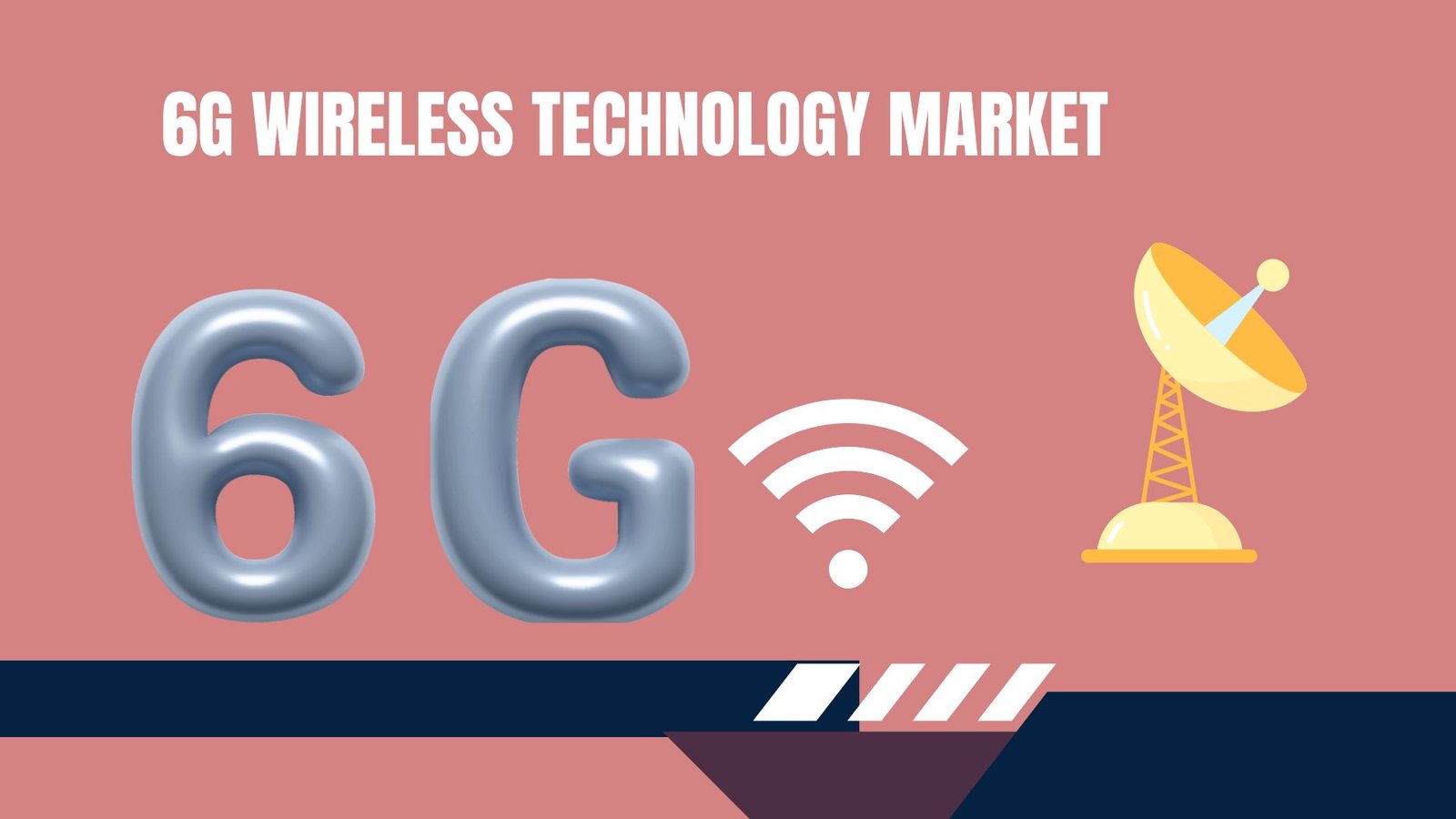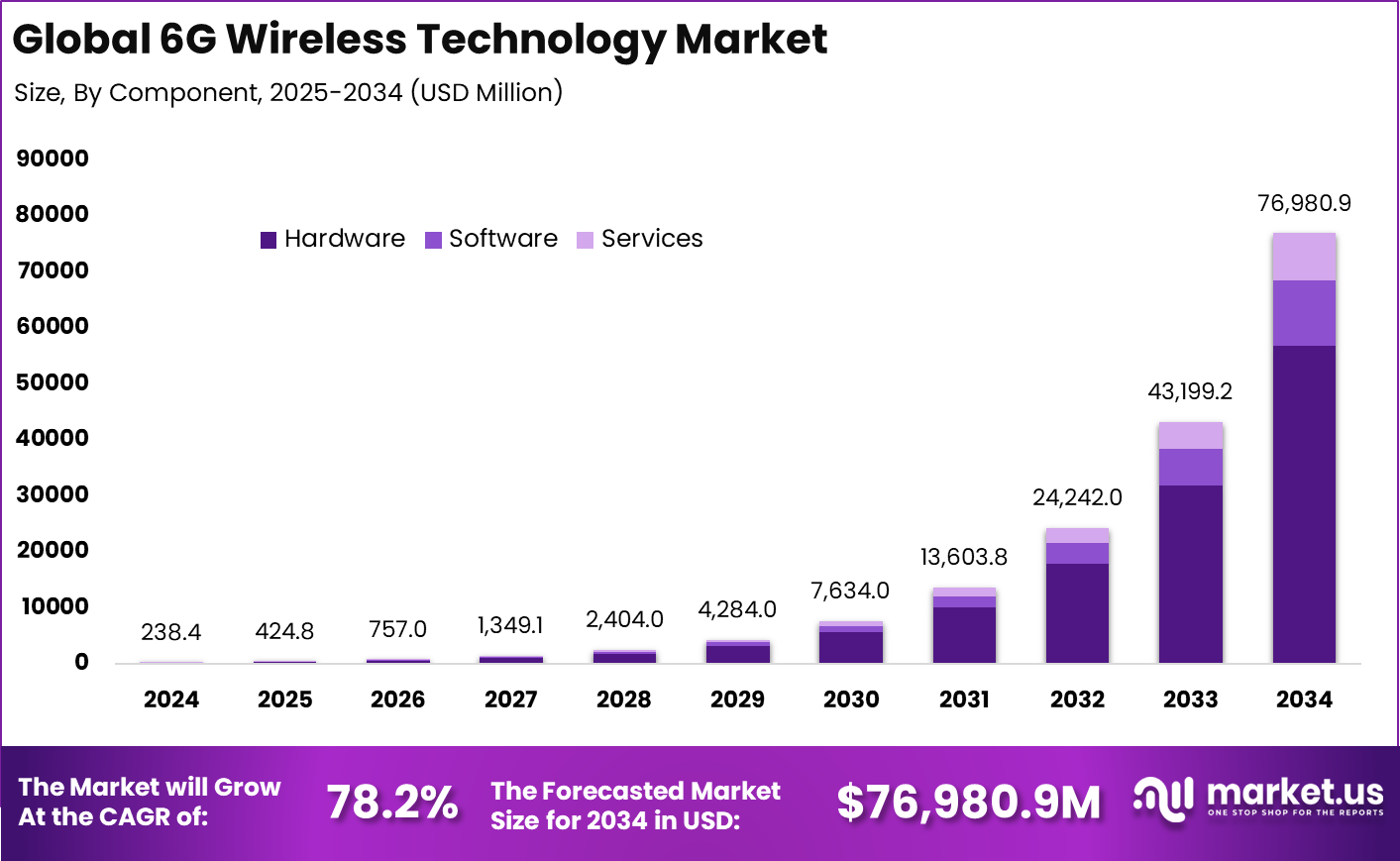6G Wireless Technology Market to hit USD 76,980.9 mn by 2034
Updated · Oct 10, 2025

WHAT WE HAVE ON THIS PAGE
Introduction
The global 6G Wireless Technology Market is projected to reach approximately USD 76,980.9 million by 2034, increasing from USD 238.4 million in 2024. This growth represents a compound annual growth rate (CAGR) of 78.2% during the forecast period from 2025 to 2034. In 2024, the Asia Pacific region held a leading market position with a share of over 39.2%, generating revenue of about USD 93.45 million.
The 6G wireless technology market is emerging as a transformative phase in wireless communications, promising speeds of up to 1 terabit per second and ultra-low latency below one millisecond. This technology aims to vastly expand network capacity and support immersive digital experiences like real-time holography, augmented reality, and autonomous systems essential for smart cities. The rapid growth in connected devices and the demand for higher performance beyond 5G are fueling this evolution, with industries such as telecommunications leading the way in adoption.
Top driving factors for 6G adoption include the increasing need for ultra-fast, reliable networks with minimal delays, enhanced security via AI-driven threat detection, and sustainable energy management. The market is propelled by rising data traffic from billions of connected devices and the requirement for sophisticated applications in IoT, autonomous machines, and cloud robotics. National interests in digital sovereignty and technological leadership also accelerate investments and innovation in 6G infrastructure.

Top Market Takeaway
- In 2024, Hardware led with a 73.98% share, underscoring the critical role of devices and infrastructure in building 6G networks.
- The THz segment dominated with 78.1%, positioning it as the foundational spectrum for ultra-high-speed, low-latency connectivity.
- Enhanced Mobile Broadband (eMBB) represented 56.3%, driven by demand for immersive digital experiences and data-intensive applications.
- The Telecommunications sector captured 62.1%, reflecting its leadership in early investments and deployment of 6G technologies.
- The China 6G market reached USD 45.05 million in 2024 and is projected to expand at a remarkable CAGR of 84.4%, highlighting its aggressive push in next-generation wireless innovation.
- Asia Pacific held the largest regional share at 39.2%, supported by strong R&D efforts, government initiatives, and extensive trial programs.
Analysts’ Viewpoint
Demand analysis reveals that telecom operators constitute the largest segment by usage, accounting for over 60% of the market share. The demand is driven by expanding digital economies and data-intensive applications like connected vehicles and industrial IoT. New services requiring extremely low latency and high reliability are pushing telecom operators to invest heavily in 6G-ready hardware and networks to meet consumer and enterprise needs.
The increasing adoption of 6G is closely linked to breakthrough technologies such as terahertz communications, AI-managed intelligent networks, and edge computing. Around 30% of ongoing 6G research is focused on terahertz frequencies which enable ultra-high-speed data transfer. AI and machine learning enhance network responsiveness and security, crucial for handling the forecasted 75 billion wireless devices worldwide by 2025, making these technologies central to 6G deployment.
Key reasons for adopting 6G include the capability to achieve instantaneous data transmission crucial for applications like remote surgeries and autonomous vehicles. The technology also supports immersive user experiences and operational efficiency in industries. Businesses anticipate the ability to offer smarter services, reduce operational costs with energy-efficient networks, and enjoy competitive advantages in a hyper-connected digital landscape.
Investment and Business benefits
Investment opportunities abound in upgrading transport networks, infrastructure, and development of 6G-enabled devices. The market is attracting heavy capital for R&D in photonic radios, integrated sensing and communication, and AI convergence technologies. Growing demand for 6G infrastructure promises substantial returns, especially in regions with dominant telecom sectors and supportive regulatory policies.
Business benefits of 6G include improved network reliability, ultra-fast speeds, enhanced connectivity, and revolutionary application development. It allows enterprises to streamline operations, boost customer engagement, and develop innovative products in healthcare, entertainment, and smart city management. Additionally, 6G emphasizes sustainability by reducing energy use through AI-driven network optimization, aligning business growth with environmental goals.
The regulatory environment surrounding 6G involves complex global coordination on spectrum allocation, standardization, and interference management. Spectrum bands between 7 to 24 GHz are being evaluated, with a focus on ensuring open, secure, and resilient networks. International collaboration among countries is shaping policies to promote interoperability, secure licensing, and consumer protection, which are foundational to smooth 6G deployment.
Driver Analysis
Demand for Ultra-Fast Connectivity
The rapid expansion of digital ecosystems and the surge in data-intensive applications are driving the demand for ultra-fast, highly reliable wireless connectivity. Emerging technologies like real-time holographic communication, autonomous vehicles, and immersive virtual reality environments require data speeds and responsiveness far beyond what 5G networks can offer.
6G technology is designed to meet these demands by delivering peak speeds up to 1 terabit per second with latency below 0.1 milliseconds. This capability enables new, seamless user experiences and supports innovative applications that were previously impossible. The increasing need for low latency and high bandwidth is fueling strong investment and innovation in 6G wireless architectures, leading toward commercial availability by 2030.
This growing demand spans multiple sectors, including telecommunications, automotive, healthcare, and smart cities, highlighting the broad market necessity for 6G. Companies and governments are actively investing in research and infrastructure development to be ready for this technological leap, positioning 6G as a key enabler of future digital transformation and economic growth.
Restraint Analysis
Spectrum Scarcity and Propagation Limits
One of the main challenges holding back 6G deployment is the limited availability of suitable wireless spectrum and the physical constraints of using higher frequencies such as terahertz bands. While higher frequency bands offer the capacity for extremely fast data transmission, they also encounter severe signal loss, limited coverage range, and poor penetration through obstacles such as buildings and weather conditions. These factors necessitate a dense infrastructure of base stations or repeaters to maintain network integrity, significantly increasing the complexity and cost of rollout.
This spectrum scarcity and the propagation limitations complicate network design and create economic barriers to fast, wide-scale adoption of 6G technology. The technical hurdles in effectively utilizing these high-frequency bands remain a significant restraint in the market, as industry players continue to explore techniques like advanced antenna systems and AI-driven network management to offset these issues.
Opportunity Analysis
Integration of AI and Enhanced Network Intelligence
The integration of artificial intelligence (AI) with 6G networks presents a promising opportunity to revolutionize wireless communication. AI can create self-optimizing networks that dynamically allocate resources, predict network traffic demands, and minimize latency and outages. This smart management leads to highly efficient, adaptive wireless systems that improve reliability and significantly reduce energy consumption.
Such advancements open new possibilities for applications in smart cities, industrial automation, and personalized services, allowing businesses to develop novel digital experiences and business models. Collaborations between wireless technology companies and AI firms are accelerating developments in network intelligence, positioning 6G as a platform not only for faster data transmission but also for intelligent and sustainable connectivity solutions.
Challenge Analysis
High Development Costs and Technological Complexity
Developing 6G wireless technology faces substantial financial and technical challenges. The cost of research, infrastructure setup, and network deployment is very high due to the need for new hardware capable of handling ultra-high data rates and ultra-low latency. Building 6G infrastructure demands advances in antennas, signal processing, and network components that are still under development, requiring significant capital investment and long development timelines.
On top of the costs, the complexity of integrating new technologies like terahertz communications, AI-driven network management, and multi-layered network architectures introduces engineering difficulties. Ensuring interoperability, security, and reliable performance within this new framework requires extensive testing, standardization, and collaboration across industries and governments. These factors slow commercial rollout and require careful management of resources and strategic partnerships.
Key Market Segments
By Component
- Hardware
- Software
- Services
By Spectrum Band
- Sub-THz
- THz
By Application
- Enhanced Mobile Broadband
- Ultra-Reliable Low Latency Communications
- Massive Machine Type Communications
- Others
By End-Use
- Telecommunications
- Automotive
- Healthcare
- Manufacturing
- Media and Entertainment
- Others
Top Key Players in the Market
- Huawei Technologies
- Nokia Corporation
- Ericsson AB
- Cisco Systems Inc.
- ZTE Corporation
- LG Electronics
- Sony Corporation
- NEC Corporation
- AT&T Inc.
- Verizon Communications Inc.
- SK Telecom Co., Ltd.
- NTT DoCoMo, Inc.
- China Mobile Limited
- Deutsche Telekom AG
- Others
Source of information @ https://market.us/report/6g-wireless-technology-market/

Joseph D'Souza started Techno Trenz as a personal project to share statistics, expert analysis, product reviews, and tech gadget experiences. It grew into a full-scale tech blog focused on Technology and it's trends. Since its founding in 2020, Techno Trenz has become a top source for tech news. The blog provides detailed, well-researched statistics, facts, charts, and graphs, all verified by experts. The goal is to explain technological innovations and scientific discoveries in a clear and understandable way.










